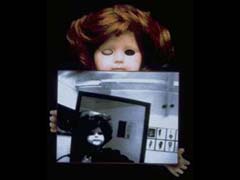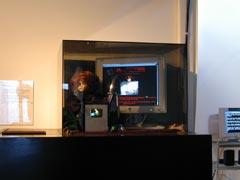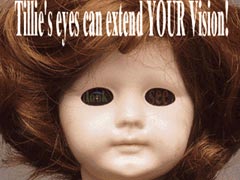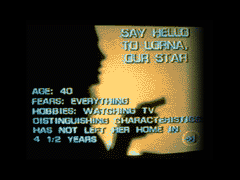| http://www.lynnhershman.com/tillie |
 |
|||
| |
|
In 1973 Hershman created Lorna, the first ever artist's interactive
videodisc. Presented in a living room setting, the viewer could interact
with Lorna by clicking the remote control to trigger different sequences
about her life. Lorna was, in some senses, a virtual counterpart to
Hershman's earlier alter ego, Roberta Breitmore, for whom she created
a quotidian existence, complete with bank accounts and diet regimens.
With Tillie, first deployed in 1995, Hershman continues her experimentation with technology and exploration of issues of identity but with a telematic twist. Via the Internet, participants can direct Tillie's gaze and view images of what she is seeing. Our seeing is extended via the network, and this vision prosthesis, in Hershman's words, makes us cyborg-wetware with machine augmentation. Issues of identity are further hybridized because through one eye Tillie sees what is in the physical world, while through the other, she captures images from the Internet, an equally real environment for we cyborgs. Lynn Hershman, July 2000 Reliance on tracking and surveillance techniques has resulted in a culture that has a peripheral vision that extends beyond normal human physiology. In many cases, there is a merging of human and machine capabilities that create new beings, cyborgs, whose virtual reach and, in this case, sight is extended beyond physical location. Identity becomes intangible on the Internet and Tillie's face becomes a mask for the multiple expressions of the self that links each person to another. By looking at the world through Tillie, the Telerobotic Doll's eyes, viewers not only become voyeurs, but indeed, become virtual cyborgs. Viewers literally use the doll's eyes as a vehicle for their own remote and extended vision. The doll is constructed so that her two eyes are replaced by two cameras. These become the "eye-cons" that move the doll physically and telerobotically. The left eye sees in color and records exactly what she sees in real time. The right eye is connected to the Internet and sees in a 320 x 200 gray scale, refreshed at a rate of 30 seconds, to accommodate visitors with slow connections. Physical Reflections Virtual Reflex-ions Viewers on the Internet can rotate Tillie's head and survey the room she is in, and send images back through the Internet to the page. A mirror placed in front of Tillie allows the visitors in the real and virtual space, multiple views of the room. Technical Information |




